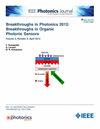光子学突破2024:使用可重构集成光子处理器的任意模式操纵
IF 2.4
4区 工程技术
Q3 ENGINEERING, ELECTRICAL & ELECTRONIC
引用次数: 0
摘要
光学模式提供了空间自由度,可以在各种应用程序中实现高级功能。传统的光子器件用于模式的操纵操作在特定系统的预定族的特征模式。在这里,我们报告了我们最近的研究发现,我们证明了可重构光子集成电路(PICs)可以通过任意系统自动识别最佳通信模式,始终确保可实现的最大功率传输和相互正交性。这些模态是在没有任何预先计算或系统的先验知识的情况下就地确定的。我们的研究结果将现有模式操作方案的概念和应用范围扩展到更复杂的功能和现实场景。我们还介绍了用于产生和检测任意、结构化和随机光束的可重构PICs的最新相关工作,并概述了在不同的自由空间和导波技术上取得的主要成果。讨论了所提出的方法的主要局限性以及在不同和新兴应用领域的潜在影响。本文章由计算机程序翻译,如有差异,请以英文原文为准。
Photonics Breakthroughs 2024: Arbitrary Mode Manipulation Using Reconfigurable Integrated Photonic Processors
Optical modes offer spatial degrees of freedom that can be exploited to implement advanced functionalities across various applications. Conventional photonic devices used for the manipulation of modes operate on predetermined families of eigenmodes of specific systems. Here, we report on a recent finding of our research, where we demonstrate that reconfigurable photonic integrated circuits (PICs) can automatically identify optimal communication modes through arbitrary systems, always ensuring maximum achievable power transmission and mutual orthogonality. Such modes are determined in situ without any precalculation or prior knowledge of the system. Our results extend the concepts and the range of applications of existing schemes for mode manipulation to more complex functionalities and realistic scenarios. We also address recent related works on reconfigurable PICs for generation and detection of arbitrary, structured, and random beams, with an overview of the main results achieved on the different free-space and guided-waves technologies. A discussion of the main limits of the presented approach and the potential implications in diverse and emerging application fields is provided.
求助全文
通过发布文献求助,成功后即可免费获取论文全文。
去求助
来源期刊

IEEE Photonics Journal
ENGINEERING, ELECTRICAL & ELECTRONIC-OPTICS
CiteScore
4.50
自引率
8.30%
发文量
489
审稿时长
1.4 months
期刊介绍:
Breakthroughs in the generation of light and in its control and utilization have given rise to the field of Photonics, a rapidly expanding area of science and technology with major technological and economic impact. Photonics integrates quantum electronics and optics to accelerate progress in the generation of novel photon sources and in their utilization in emerging applications at the micro and nano scales spanning from the far-infrared/THz to the x-ray region of the electromagnetic spectrum. IEEE Photonics Journal is an online-only journal dedicated to the rapid disclosure of top-quality peer-reviewed research at the forefront of all areas of photonics. Contributions addressing issues ranging from fundamental understanding to emerging technologies and applications are within the scope of the Journal. The Journal includes topics in: Photon sources from far infrared to X-rays, Photonics materials and engineered photonic structures, Integrated optics and optoelectronic, Ultrafast, attosecond, high field and short wavelength photonics, Biophotonics, including DNA photonics, Nanophotonics, Magnetophotonics, Fundamentals of light propagation and interaction; nonlinear effects, Optical data storage, Fiber optics and optical communications devices, systems, and technologies, Micro Opto Electro Mechanical Systems (MOEMS), Microwave photonics, Optical Sensors.
 求助内容:
求助内容: 应助结果提醒方式:
应助结果提醒方式:


